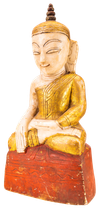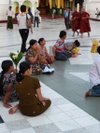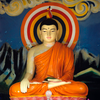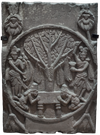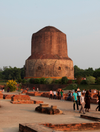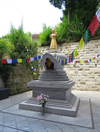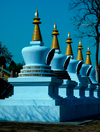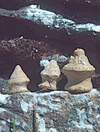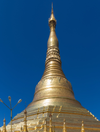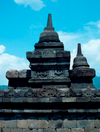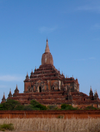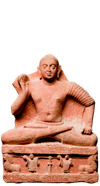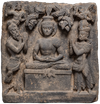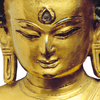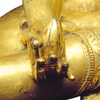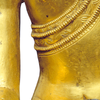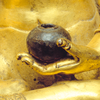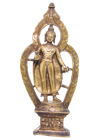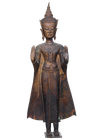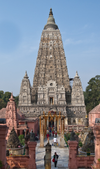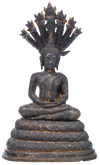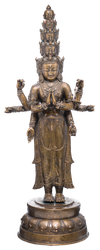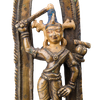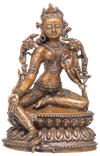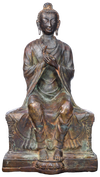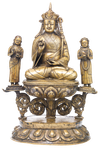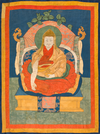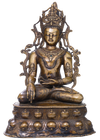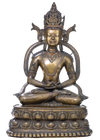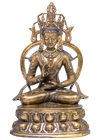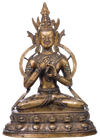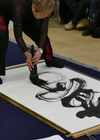Project management
Museum der Kulturen Basel: Andrea Mašek
maze pictures GmbH: Siri van den Berg, Ann-Sophie Wilkening, Maria Hermann
Editors
Concept and texts: Stephanie Lovász, Ursula Regehr, Silvia Greber
Dramaturgy: Herbert Schwarze, Chantal Eschenfelder
Web Design and programming
Agenturfuerkrankemedien (AFKM), coordination Christoph Perl
Maps: Stefan Köther
Photography
Objects: Omar Lemke © Museum der Kulturen Basel
In situ: Peter Thiele © Peter Thiele; Entrance of the Monasterial Tibet Institute Rikon © Tibet-Institut Rikon
Detailed Information
Creative Commons licences
Photo Bodhi Tree © Biswarup Ganguly own work, via Wikimedia Commons, CC BY-3.0, picture detail
Photo Shwedagon Pagoda © Halavar, own work, via Wikimedia Commons, CC BY-SA 4.0, picture detail
Photo Brahma and Indra © Art Institute of Chicago, CC0 Public Domain Designation, picture detail
Graphic Dharmachakra © Christopher J. Fynn, own work, via Wikimedia Commons, CC BY-SA 4.0, picture detail, colours changed
Key Visual
Buddha Shakyamuni, Myanmar, 19th c., IIb 7, collected by J.R. Geigy-Merian, gift 1854, © Museum der Kulturen Basel
Chapter Covers
Photo Buddha’s footprint © Renate Herbst, Darmstadt
Head of a Buddha, Gandhara, probably 3rd/4th c., IIa 667, collected by A. Sarasin-Iselin, gift 1934 © Museum der Kulturen Basel
Photo Mahabodhi temple in Bodhgaya, India © chaostrophy, own work, via flickr.com, CC BY-SA 2.0, unchanged
Calligraphy performance of artist Sanae Sakamoto © Konrad Scheuber
Zoom-ins
Buddha Shakyamuni as a prince, Tibet, 16th c., IId 13889, collected by G.-W. Essen, purchased 1998 © Museum der Kulturen Basel
Buddha Shakyamuni, Thailand, before 1950, IIb 1634, collected by L. Paravicini, gift from estate 1951 © Museum der Kulturen Basel
Bodhisattva Avalokiteshvara, Tibet, 15th c., IId 13927, collected by G.-W. Essen, purchased 1998 © Museum der Kulturen Basel
Buddha Maitreya, Tibet, 9th/10th c., IId 13895, collected by G.-W. Essen, purchased 1998 © Museum der Kulturen Basel
Koans
Koan 1 & 2 From: Zenkei Shibayama, Zu den Quellen des Zen. Die berühmten Koans des Meisters Mumon aus dem 13. Jahrhundert. Mit Einführung und Kommentar, 1976, München: Otto Wilhelm Barth Verlag
Koan 3 From: Mumonkan, Die Schranke ohne Tor. Meister Wu-men’s Sammlung der achtundvierzig Koan. Aus dem Chinesischen übersetzt und erläutert von Heinrich Dumoulin, 1975, Mainz: Grünewald
Koan 4 From: Genro Oryu, Imai Fukuzan (ed.), Koan-Sammlung. Shumon kattoshu („Verwickelte Ranken“), Tetteki tosui („Eiserne Flöte“), Shonan Kattoroku („Der Zen-Weg der Samurai“), 2016, Frankfurt: Angkor Verlag
Koan 5 is attributed to the Chinese Chan monk Linji Yixuan.
Illustration Kensho © Tagebuch eines Zen-Lehrlings, Zeichnungen und Text von Sato Giei, Pfullingen: Neske 1988


